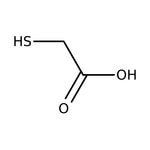Search Thermo Fisher Scientific
Thermo Scientific Chemicals
Mercaptoacetic acid, 97+%, Thermo Scientific Chemicals
Catalog number: B20391.22
100 g, Each



Thermo Scientific Chemicals
Mercaptoacetic acid, 97+%, Thermo Scientific Chemicals
Catalog number: B20391.22
100 g, Each
Quantity
Catalog number: B20391.22
also known as B20391-22
Price (USD)
Price: 34.70
Online price: 29.65
Your price:
Quantity
-
Chemical Identifiers
CAS
68-11-1
IUPAC Name
2-sulfanylacetic acid
Molecular Formula
C2H4O2S
InChI Key
CWERGRDVMFNCDR-UHFFFAOYSA-N
SMILES
OC(=O)CS
Specifications
Comment
Material sourced in the U.S. and in other countries
Identification (FTIR)
Conforms (non-U.S. sourced material)
Proton NMR
Conforms to structure (non-U.S. sourced material)
Refractive Index
1.5020-1.5070 @ 20°C (non-U.S. sourced material)
Form
Liquid
Description
Reagent that protects tryptophan in amino acid analysis.Mercaptoacetic acid is used as a protecting agent for tryptophan in amino acid analysis and an acidity indicator. It finds application as an intermediate in the chemical reactions such as addition, elimination and cyclization. It acts as a precursor to ammonium thioglycolate, sodium thioglycolate and calcium thioglycolate. Its organotin derivatives are used as stabilizers for polyvinyl chloride (PVC). In organic synthesis, it acts as a nucleophile in thioglycolysis reactions and sulfur transfer agent for sulfonyl chloride synthesis. Further, it is used in leather processing.
This Thermo Scientific Chemicals brand product was originally part of the Alfa Aesar product portfolio. Some documentation and label information may refer to the legacy brand. The original Alfa Aesar product / item code or SKU reference has not changed as a part of the brand transition to Thermo Scientific Chemicals.
Applications
Reagent that protects tryptophan in amino acid analysis.Mercaptoacetic acid is used as a protecting agent for tryptophan in amino acid analysis and an acidity indicator. It finds application as an intermediate in the chemical reactions such as addition, elimination and cyclization. It acts as a precursor to ammonium thioglycolate, sodium thioglycolate and calcium thioglycolate. Its organotin derivatives are used as stabilizers for polyvinyl chloride (PVC). In organic synthesis, it acts as a nucleophile in thioglycolysis reactions and sulfur transfer agent for sulfonyl chloride synthesis. Further, it is used in leather processing.
Solubility
Miscible with water, ethanol, ethers, ketones, esters, chlorinated hydrocarbons, benzene and aromatic hydrocarbons. Slightly miscible with chloroform.
Notes
Air sensitive. Incompatible with strong oxidizing agents and strong acids.
Reagent that protects tryptophan in amino acid analysis.Mercaptoacetic acid is used as a protecting agent for tryptophan in amino acid analysis and an acidity indicator. It finds application as an intermediate in the chemical reactions such as addition, elimination and cyclization. It acts as a precursor to ammonium thioglycolate, sodium thioglycolate and calcium thioglycolate. Its organotin derivatives are used as stabilizers for polyvinyl chloride (PVC). In organic synthesis, it acts as a nucleophile in thioglycolysis reactions and sulfur transfer agent for sulfonyl chloride synthesis. Further, it is used in leather processing.
Solubility
Miscible with water, ethanol, ethers, ketones, esters, chlorinated hydrocarbons, benzene and aromatic hydrocarbons. Slightly miscible with chloroform.
Notes
Air sensitive. Incompatible with strong oxidizing agents and strong acids.
RUO – Research Use Only
Figures
Documents & Downloads
Certificates
Search by lot number or partial lot number
Frequently asked questions (FAQs)
Citations & References
Search citations by name, author, journal title or abstract text